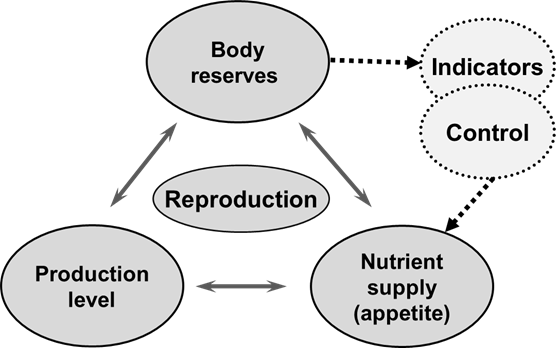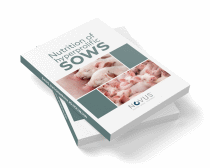|
18 February 2020- Novus recently published a book entitled Nutrition of Hyperprolific Sows, intended to be a practical text offering nutritional solutions to help producers protect their margins and generate discussion about nutrition’s role in addressing some of the welfare and production issues that have come up as sows are enabled to exceed their genetic potential. Feedinfo takes up this conversation with Jean-Yves Dourmad, a senior researcher at INRA-Agrocampus Ouest and a contributor to Novus’s book. In the interview below, Dr. Dourmad discusses how the needs of sows have evolved over the last decade, as has our knowledge of how best to meet those needs, concluding with a brief discussion of the existing and near-term tools to help producers put these new findings into action. |
|
[Jean-Yves Dourmad] It can be estimated that milk production and litter growth rate have increased by more than 70% since the eighties, resulting in a drastic increase in energy, amino-acids and minerals requirements. At the same time sows’ spontaneous feed intake remained quite constant and consequently the risk of nutrient deficiency increased drastically. However, due to the large number of factors affecting sows' feed intake, the situation is highly variable in practice.
Between farms, although not well documented in the literature, there is a quite high variability in average lactation feed intake. These variables can be a result related to the design of housing and feeding systems, the climate, the feeding practices and to some extent to the commercial lines of the sows.
Within a farm, lactating sow feed intake depends largely on sow parity. First and to some extent second parity sows eat about 20% less than multiparous sows, although their milk production is similar. This results in an increased energy and nutrient deficit in young sows, associated with an increase of body protein and lipid mobilization with consequently a higher risk of reproductive troubles at weaning. In multiparous sows, spontaneous feed intake gets much closer to the requirements and mobilization of body reserves is limited. Moreover, these sows are much less sensitive than first litter sows to reproductive disorder at weaning.
Ambient temperature is the main environmental factor affecting sow feed intake resulting in an increased risk of energy and nutrient deficiency during summer and in regions with a hot climate. Different floor and air cooling systems have been shown to be effective at increasing feed intake in such situations. A separate regulation of piglet nest and room ambient temperature may also be very effective. Modifying the composition of the diet by reducing its heat increment has also been shown to be effective to increase net energy intake.
Adapting the nutrient content of the diet, especially the amino acids, minerals and vitamins, to reflect sow feed intake allows sufficient daily supplies, even when appetite is reduced. This can be performed according to the season to compensate for the reduced feed intake during summer, according to parity to take account of the lower feed intake of first parity sows, or even according to individual sows when using smart feeders allowing the individual mixing of different diets.
[Feedinfo News Service] Feeding programs for sows aim at an optimal sow body condition, avoiding sows getting too thin (causing piglet birthweight problems) or too fat (reproductive failure after weaning). But is optimal sow body condition really just a question of body fat reserves, or do other parameters (body protein mass) also need to be considered here? How is our understanding of an optimal sow body condition evolving?
[Jean-Yves Dourmad] The risk of reproductive troubles in sows at weaning, including delayed return into estrus, low conception rate and reduced prolificacy in the next litter, has been shown to be associated with an excessive mobilization of body fat and/or body protein reserves during lactation, especially in young sows. That is why it is generally recommended to adapt the daily nutritional supplies during lactation as close as possible to the requirements in order to maximize milk production and avoid an excessive mobilization of body reserves.
In practice, this implies feeding the sows close to their ad-libitum intake. In the past, a great deal of attention has been paid to the role of body fat reserves at weaning. However, more recent studies in high producing lean animals suggest that body protein mass also plays an important role - perhaps the most important one - especially in young sows that are still growing. Nevertheless, in practice, the risk of reproductive troubles after weaning have tended to decrease over the past decades, although the body fatness of sows (backfat depth) was reduced and milk production was increased, due to selection. This seems to indicate that selection tended to reduce the sensitivity of reproduction to sows’ body condition at weaning. As a result, usual targets of body fatness at weaning has tended to decrease, from 18-20 mm in the 1980s to 15-17 mm nowadays, although this depends on commercial genetic lines.
At parturition, body reserves should not be excessive to avoid farrowing problems such as postpartum dysgalactia syndrome (PDS) which is common in high body fat sows. Higher frequency of PDS in too-fat sows at parturition, especially when it exceeds 21 mm at farrowing, may also be associated with longer parturition, increased stillbirth and reduced longevity. Conversely, too thin sows at parturition have lighter piglets at birth and at weaning. Indeed, sow energy intake during pregnancy, which affects sow body condition at farrowing also affects piglets' birth weight. This suggests that there should be an optimal range for sow body condition at farrowing, in relation with energy supply, resulting from a compromise between increasing piglets' weight at birth and their survival, and limiting the risk of occurrence of sow peripartum and locomotor disorders. This also raises the question of the optimal body condition of sows at insemination. If body condition is "too good" at weaning, feeding level during gestation has to be restrained in order to avoid excessive body condition at farrowing, resulting in lighter piglet birth weight. This logic would be in favor of feeding strategies with a moderate/controlled mobilization of body reserves during lactation, which is in fact a rather natural process.
Much less attention has been paid in the literature to mineral body reserves, although it may be expected that they may also vary along the reproductive cycle and among sows. However, the mineral status of sows is more difficult to assess in practice and is not yet considered in nutritional models for the prediction of requirements.
Nutritional supplies to sows have thus to be modulated to maintain body reserves so that the sows will be in optimal condition throughout their productive life, thereby optimizing reproductive performance. On farm, this requires adjusting the feeding level and feed composition according to the performance of individual sows and also to housing conditions, which may affect nutrient requirements and voluntary feed intake. Optimal reproduction can be represented as depending on a "tripod" involving the status of body reserves, the supply of nutrients and the production level. Body condition, estimated from body scoring or measurement of backfat thickness and body weight can be used as indicators of the status of body protein and reserves and used to "control" the balance through the adaptation of nutrient supplies.

General description of the effects on reproduction, of nutrient supplies, body reserves and production level.
[Feedinfo News Service] To what extent do practical nutritional models for the feeding of hyperprolific sows exist? Is it fair to say that this is an underdeveloped area compared to, say, growing pigs?
[Jean-Yves Dourmad] Compared to growing pigs, few nutritional models have been published for sows and most of them are research models, not really available for practical application. Among the models that can be used in practice, the National Research Council (NRC) model predicts energy, amino acids and minerals requirements according to a factorial approach. This model is available as a spreadsheet. In the same way, InraPorc® decision-support tool allows the factorial calculation of energy, amino acids and mineral requirements according to farm performance, but in addition, it includes a simulation model that allows simulating the short- and long-term response of sows to a feeding strategy.
These models have mainly been developed on the basis of the scientific knowledge produced over the past 25 years, mainly on sows with conventional performance. Nevertheless, because they consider the performance of sows as inputs they can be used with confidence for the determination of nutrient requirements of hyperprolific sows.
With the increasing availability of on-farm data collected by farmers or sensors on performance (e.g. prolificacy, litter growth, etc.) characteristics (e.g. body weight, backfat thickness) and behaviour (e.g. physical activity, feeding behaviour) of sows and their housing conditions (e.g. ambient temperature) a new generation of models is in development that should allow the real-time determination, on a daily basis, of individual sow’s requirements. This is a new paradigm of "data-ready and precision-feeding-ready" models able to process both historical farm data (e.g. for ex-post assessment of nutrient requirements) and real-time data (e.g. to control precision feeding). In that perspective we recently published two models in the Journal of Animal Science, one for pregnancy (Gaillard et al., 2019, doi.org/10.1093/jas/skz320 ) and one for lactation (Gauthier et al., 2019, doi.org/10.1093/jas/skz167 )
Published in association with Novus International.
To read part I of the discussion on the nutrition of hyperprolific sows, click here.




